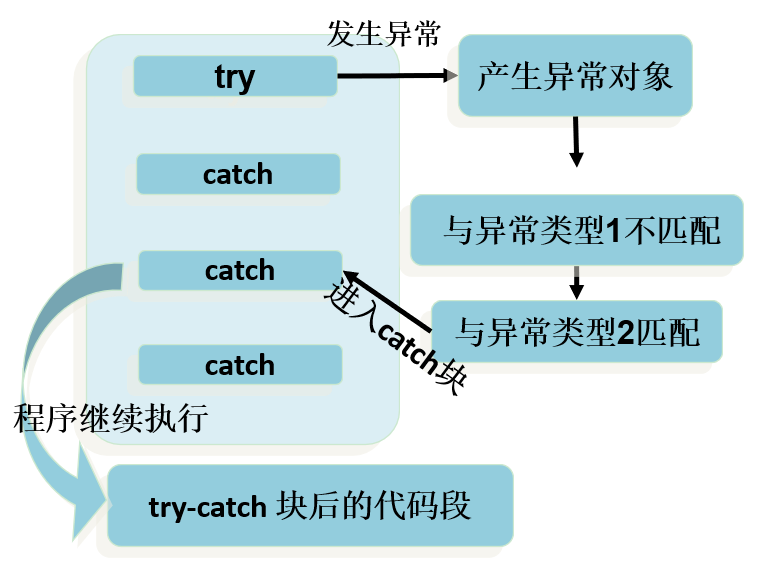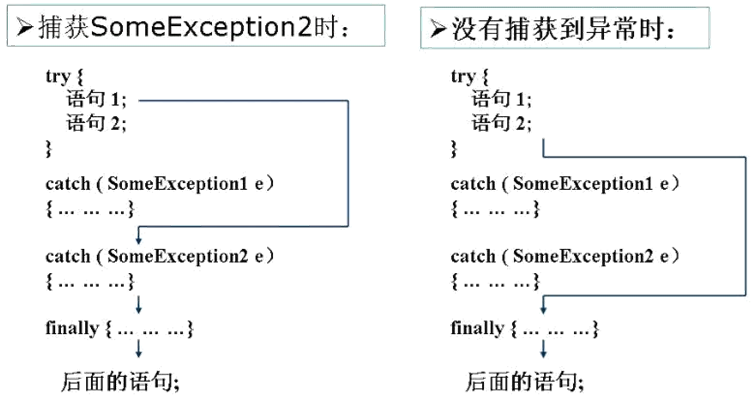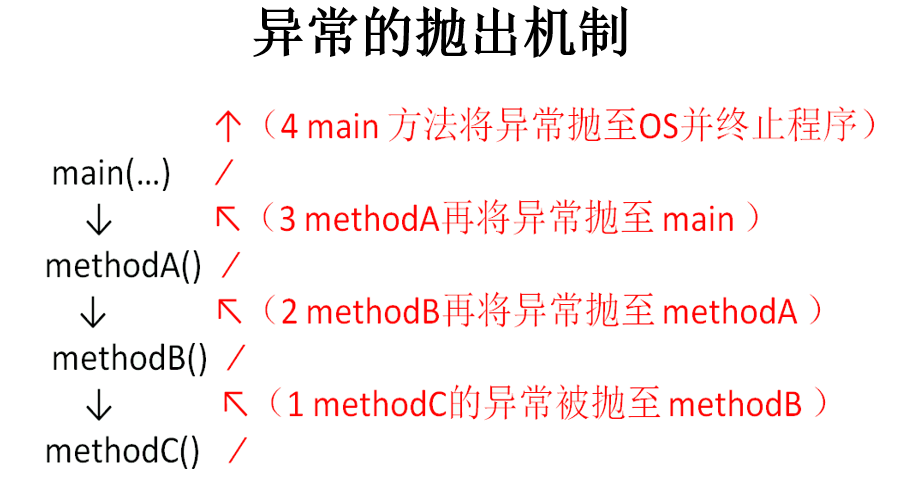1. 异常处理概述
在编写程序时,经常要在可能出现错误的地方加上检测的代码,如进行x/y运算时,要检测分母为0,数据为空,输入的不是数据而是字符等。过多的if-else分支会导致程序的代码加长、臃肿,可读性差,程序员需要花很大的精力“堵漏洞”。因此采用异常处理机制。
2. 异常处理方式1:捕获异常(try-catch-finally)
Java提供了异常处理的抓抛模型。
-
前面提到,Java程序的执行过程中如出现异常,会生成一个异常类对象,该异常对象将被提交给Java运行时系统,这个过程称为
抛出(throw)异常。 -
如果一个方法内抛出异常,该异常对象会被抛给调用者方法中处理。如果异常没有在调用者方法中处理,它继续被抛给这个调用方法的上层方法。这个过程将一直继续下去,直到异常被处理。这一过程称为
捕获(catch)异常。 -
如果一个异常回到main()方法,并且main()也不处理,则程序运行终止。
2.1 try-catch-finally基本格式
捕获异常语法如下:
try{
...... //可能产生异常的代码
}
catch( 异常类型1 e ){
...... //当产生异常类型1型异常时的处置措施
}
catch( 异常类型2 e ){
...... //当产生异常类型2型异常时的处置措施
}
finally{
...... //无论是否发生异常,都无条件执行的语句
}
1、整体执行过程:
当某段代码可能发生异常,不管这个异常是编译时异常(受检异常)还是运行时异常(非受检异常),我们都可以使用try块将它括起来,并在try块下面编写catch分支尝试捕获对应的异常对象。
-
如果在程序运行时,try块中的代码没有发生异常,那么catch所有的分支都不执行。
-
如果在程序运行时,try块中的代码发生了异常,根据异常对象的类型,将从上到下选择第一个匹配的catch分支执行。此时try中发生异常的语句下面的代码将不执行,而整个try…catch之后的代码可以继续运行。
-
如果在程序运行时,try块中的代码发生了异常,但是所有catch分支都无法匹配(捕获)这个异常,那么JVM将会终止当前方法的执行,并把异常对象“抛”给调用者。如果调用者不处理,程序就挂了。

2、try
- 捕获异常的第一步是用
try{…}语句块选定捕获异常的范围,将可能出现异常的业务逻辑代码放在try语句块中。
3、catch (Exceptiontype e)
-
catch分支,分为两个部分,catch()中编写异常类型和异常参数名,{}中编写如果发生了这个异常,要做什么处理的代码。
-
如果明确知道产生的是何种异常,可以用该异常类作为catch的参数;也可以用其父类作为catch的参数。
比如:可以用ArithmeticException类作为参数的地方,就可以用RuntimeException类作为参数,或者用所有异常的父类Exception类作为参数。但不能是与ArithmeticException类无关的异常,如NullPointerException(catch中的语句将不会执行)。
-
每个try语句块可以伴随一个或多个catch语句,用于处理可能产生的不同类型的异常对象。
-
如果有多个catch分支,并且多个异常类型有父子类关系,必须保证小的子异常类型在上,大的父异常类型在下。否则,报错。
-
catch中常用异常处理的方式
-
public String getMessage():获取异常的描述信息,返回字符串 -
public void printStackTrace():打印异常的跟踪栈信息并输出到控制台。包含了异常的类型、异常的原因、还包括异常出现的位置,在开发和调试阶段,都得使用printStackTrace()。

-
2.2 使用举例
举例1:
public class IndexOutExp {
public static void main(String[] args) {
String friends[] = { "lisa", "bily", "kessy" };
try {
for (int i = 0; i < 5; i++) {
System.out.println(friends[i]);
}
} catch (ArrayIndexOutOfBoundsException e) {
System.out.println("index err");
}
System.out.println("\nthis is the end");
}
}
举例2:
public class DivideZero1 {
int x;
public static void main(String[] args) {
int y;
DivideZero1 c = new DivideZero1();
try {
y = 3 / c.x;
} catch (ArithmeticException e) {
System.out.println("divide by zero error!");
}
System.out.println("program ends ok!");
}
}
举例3:
@Test
public void test1(){
try{
String str1 = "atguigu.com";
str1 = null;
System.out.println(str1.charAt(0));
}catch(NullPointerException e){
//异常的处理方式1
System.out.println("不好意思,亲~出现了小问题,正在加紧解决...");
}catch(ClassCastException e){
//异常的处理方式2
System.out.println("出现了类型转换的异常");
}catch(RuntimeException e){
//异常的处理方式3
System.out.println("出现了运行时异常");
}
//此处的代码,在异常被处理了以后,是可以正常执行的
System.out.println("hello");
}
2.3 finally使用及举例

-
因为异常会引发程序跳转,从而会导致有些语句执行不到。而程序中有一些特定的代码无论异常是否发生,都
需要执行。例如,数据库连接、输入流输出流、Socket连接、Lock锁的关闭等,这样的代码通常就会放到finally块中。所以,我们通常将一定要被执行的代码声明在finally中。- 唯一的例外,使用 System.exit(0) 来终止当前正在运行的 Java 虚拟机。
-
不论在try代码块中是否发生了异常事件,catch语句是否执行,catch语句是否有异常,catch语句中是否有return,finally块中的语句都会被执行。
-
finally语句和catch语句是可选的,但finally不能单独使用。
举例1:确保资源关闭
package com.atguigu.keyword;
import java.util.InputMismatchException;
import java.util.Scanner;
public class TestFinally {
public static void main(String[] args) {
Scanner input = new Scanner(System.in);
try {
System.out.print("请输入第一个整数:");
int a = input.nextInt();
System.out.print("请输入第二个整数:");
int b = input.nextInt();
int result = a/b;
System.out.println(a + "/" + b +"=" + result);
} catch (InputMismatchException e) {
System.out.println("数字格式不正确,请输入两个整数");
}catch (ArithmeticException e){
System.out.println("第二个整数不能为0");
} finally {
System.out.println("程序结束,释放资源");
input.close();
}
}
@Test
public void test1(){
FileInputStream fis = null;
try{
File file = new File("hello1.txt");
fis = new FileInputStream(file);//FileNotFoundException
int b = fis.read();//IOException
while(b != -1){
System.out.print((char)b);
b = fis.read();//IOException
}
}catch(IOException e){
e.printStackTrace();
}finally{
try {
if(fis != null)
fis.close();//IOException
} catch (IOException e) {
e.printStackTrace();
}
}
}
}
举例2:从try回来
public class FinallyTest1 {
public static void main(String[] args) {
int result = test("12");
System.out.println(result);
}
public static int test(String str){
try{
Integer.parseInt(str);
return 1;
}catch(NumberFormatException e){
return -1;
}finally{
System.out.println("test结束");
}
}
}
举例3:从catch回来
public class FinallyTest2 {
public static void main(String[] args) {
int result = test("a");
System.out.println(result);
}
public static int test(String str) {
try {
Integer.parseInt(str);
return 1;
} catch (NumberFormatException e) {
return -1;
} finally {
System.out.println("test结束");
}
}
}
举例4:从finally回来
public class FinallyTest3 {
public static void main(String[] args) {
int result = test("a");
System.out.println(result);
}
public static int test(String str) {
try {
Integer.parseInt(str);
return 1;
} catch (NumberFormatException e) {
return -1;
} finally {
System.out.println("test结束");
return 0;
}
}
}
2.4 异常处理的体会
-
前面使用的异常都是
RuntimeException类或是它的子类,这些类的异常的特点是:即使没有使用try和catch捕获,Java自己也能捕获,并且编译通过 ( 但运行时会发生异常使得程序运行终止 )。所以,对于这类异常,可以不作处理,因为这类异常很普遍,若全处理可能会对程序的可读性和运行效率产生影响。 -
如果抛出的异常是IOException等类型的
非运行时异常,则必须捕获,否则编译错误。也就是说,我们必须处理编译时异常,将异常进行捕捉,转化为运行时异常。
3. 异常处理方式2:声明抛出异常类型(throws)
-
如果在编写方法体的代码时,某句代码可能发生某个
编译时异常,不处理编译不通过,但是在当前方法体中可能不适合处理或无法给出合理的处理方式,则此方法应显示地声明抛出异常,表明该方法将不对这些异常进行处理,而由该方法的调用者负责处理。

-
具体方式:在方法声明中用
throws语句可以声明抛出异常的列表,throws后面的异常类型可以是方法中产生的异常类型,也可以是它的父类。
3.1 throws基本格式
声明异常格式:
修饰符 返回值类型 方法名(参数) throws 异常类名1,异常类名2…{ }
在throws后面可以写多个异常类型,用逗号隔开。
举例:
public void readFile(String file) throws FileNotFoundException,IOException {
...
// 读文件的操作可能产生FileNotFoundException或IOException类型的异常
FileInputStream fis = new FileInputStream(file);
//...
}
3.2 throws 使用举例
举例:针对于编译时异常
package com.atguigu.keyword;
public class TestThrowsCheckedException {
public static void main(String[] args) {
System.out.println("上课.....");
try {
afterClass();//换到这里处理异常
} catch (InterruptedException e) {
e.printStackTrace();
System.out.println("准备提前上课");
}
System.out.println("上课.....");
}
public static void afterClass() throws InterruptedException {
for(int i=10; i>=1; i--){
Thread.sleep(1000);//本来应该在这里处理异常
System.out.println("距离上课还有:" + i + "分钟");
}
}
}
举例:针对于运行时异常:
throws后面也可以写运行时异常类型,只是运行时异常类型,写或不写对于编译器和程序执行来说都没有任何区别。如果写了,唯一的区别就是调用者调用该方法后,使用try…catch结构时,IDEA可以获得更多的信息,需要添加哪种catch分支。
package com.atguigu.keyword;
import java.util.InputMismatchException;
import java.util.Scanner;
public class TestThrowsRuntimeException {
public static void main(String[] args) {
Scanner input = new Scanner(System.in);
try {
System.out.print("请输入第一个整数:");
int a = input.nextInt();
System.out.print("请输入第二个整数:");
int b = input.nextInt();
int result = divide(a,b);
System.out.println(a + "/" + b +"=" + result);
} catch (ArithmeticException | InputMismatchException e) {
e.printStackTrace();
} finally {
input.close();
}
}
public static int divide(int a, int b)throws ArithmeticException{
return a/b;
}
}
3.3 方法重写中throws的要求
方法重写时,对于方法签名是有严格要求的。复习:
(1)方法名必须相同
(2)形参列表必须相同
(3)返回值类型
– 基本数据类型和void:必须相同
– 引用数据类型:<=
(4)权限修饰符:>=,而且要求父类被重写方法在子类中是可见的
(5)不能是static,final修饰的方法
此外,对于throws异常列表要求:
-
如果父类被重写方法的方法签名后面没有 “throws 编译时异常类型”,那么重写方法时,方法签名后面也不能出现“throws 编译时异常类型”。
-
如果父类被重写方法的方法签名后面有 “
throws 编译时异常类型”,那么重写方法时,throws的编译时异常类型必须 <= 被重写方法throws的编译时异常类型,或者不throws编译时异常。 -
方法重写,对于“
throws 运行时异常类型”没有要求。
package com.atguigu.keyword;
import java.io.IOException;
class Father{
public void method()throws Exception{
System.out.println("Father.method");
}
}
class Son extends Father{
@Override
public void method() throws IOException,ClassCastException {
System.out.println("Son.method");
}
}
4. 两种异常处理方式的选择
前提:对于异常,使用相应的处理方式。此时的异常,主要指的是编译时异常。
-
如果程序代码中,涉及到资源的调用(流、数据库连接、网络连接等),则必须考虑使用try-catch-finally来处理,保证不出现内存泄漏。
-
如果父类被重写的方法没有throws异常类型,则子类重写的方法中如果出现异常,只能考虑使用try-catch-finally进行处理,不能throws。
-
开发中,方法a中依次调用了方法b,c,d等方法,方法b,c,d之间是递进关系。此时,如果方法b,c,d中有异常,我们通常选择使用throws,而方法a中通常选择使用try-catch-finally。





